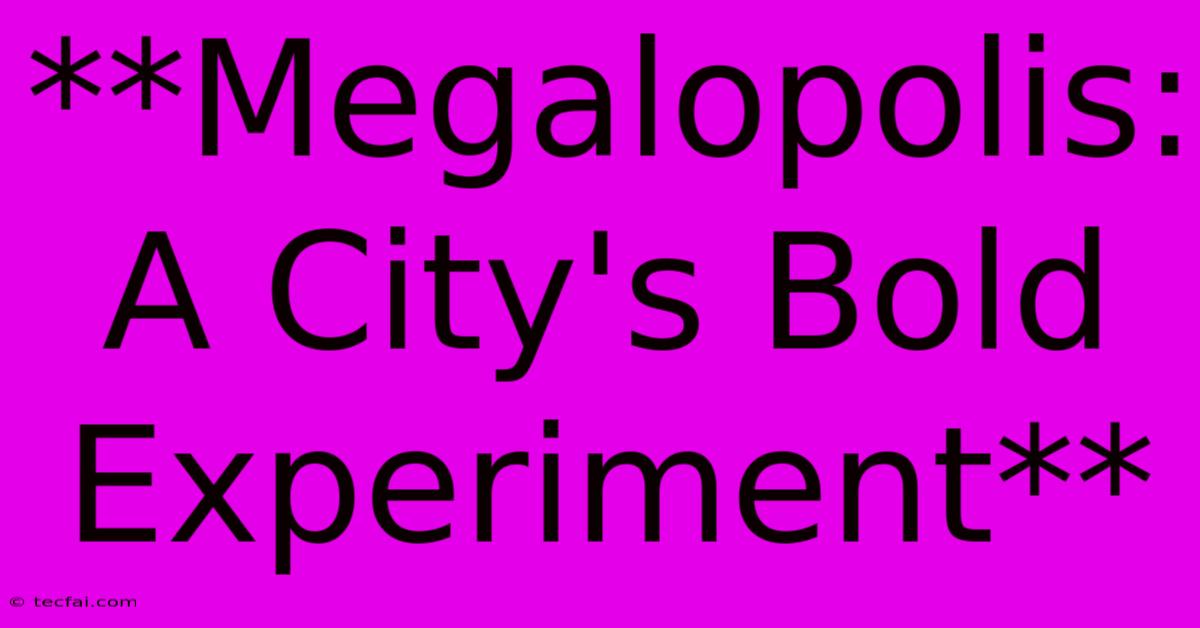**Megalopolis: A City's Bold Experiment**

Discover more detailed and exciting information on our website. Click the link below to start your adventure: Visit Best Website tecfai.com. Don't miss out!
Table of Contents
Megalopolis: A City's Bold Experiment
The concept of a "megalopolis" evokes images of sprawling urban landscapes, towering skyscrapers, and teeming populations. It's a vision of the future, where cities merge and expand, creating super-cities that redefine our urban experience. But is a megalopolis merely a futuristic fantasy, or is it a bold experiment in city planning that could hold the key to solving some of our most pressing urban challenges?
The Rise of the Megalopolis
The term "megalopolis" was coined in the mid-20th century to describe the continuous urban development stretching from Boston to Washington D.C., known as the "BosWash" corridor. Since then, the idea has taken root in other regions, with cities like Tokyo, Seoul, and Hong Kong showcasing the potential of urban amalgamation.
This trend isn't just a coincidence. As global populations grow and urban centers become increasingly crowded, the need for innovative solutions to manage resources, infrastructure, and social services becomes paramount. Megalopolis, with its promise of increased efficiency and greater economies of scale, offers a tantalizing prospect.
Advantages of a Megalopolis
The potential benefits of a megalopolis are numerous:
- Improved Infrastructure: By combining resources, megalopolises can invest in robust and efficient infrastructure, such as public transportation, water management systems, and energy networks. This leads to improved connectivity, reduced pollution, and better resource allocation.
- Economic Growth: The concentration of human capital, industry, and innovation within a megalopolis creates fertile ground for economic growth. It fosters collaboration, attracts investment, and drives technological advancements.
- Cultural Diversity: Megalopolises are melting pots of diverse cultures, fostering vibrant artistic scenes, culinary experiences, and a global exchange of ideas. This richness adds to the quality of life and contributes to a dynamic and inclusive society.
The Challenges of a Megalopolis
However, the path to a successful megalopolis is not without its challenges:
- Social Inequality: The vast scale of megalopolises can exacerbate existing social inequalities. The concentration of wealth and resources in certain areas can lead to disparities in access to housing, healthcare, and education.
- Environmental Concerns: The sheer size and density of a megalopolis can put significant pressure on the environment. Issues like air pollution, water scarcity, and waste management require careful planning and sustainable practices.
- Governance and Management: Governing and managing such a vast and complex entity presents significant challenges. Coordination between multiple cities, governments, and stakeholders is crucial for effective decision-making and implementation.
The Future of Megalopolises
The success of a megalopolis hinges on addressing these challenges. Effective planning, strong governance, and a commitment to sustainability are paramount. While the concept might seem daunting, the potential benefits of a well-managed megalopolis are too significant to ignore.
By embracing innovation, embracing diversity, and prioritizing the well-being of its citizens, the megalopolis can emerge as a model for sustainable and thriving urban environments. This "city of cities" could be the future of urban living, offering a glimpse into a world where the challenges of our time are met with creative solutions and a shared vision for a brighter future.

Thank you for visiting our website wich cover about **Megalopolis: A City's Bold Experiment**. We hope the information provided has been useful to you. Feel free to contact us if you have any questions or need further assistance. See you next time and dont miss to bookmark.
Featured Posts
-
Iowa Ag Calls Trump Prosecutions Shams
Nov 14, 2024
-
World Cup 2026 Australia Saudi Arabia Match Preview
Nov 14, 2024
-
Ags Urge Appeals Court To Dismiss Trump Indictment
Nov 14, 2024
-
Coulier Announces Cancer Diagnosis
Nov 14, 2024
-
Travis Kelces Mansion Gets A Big Addition
Nov 14, 2024
